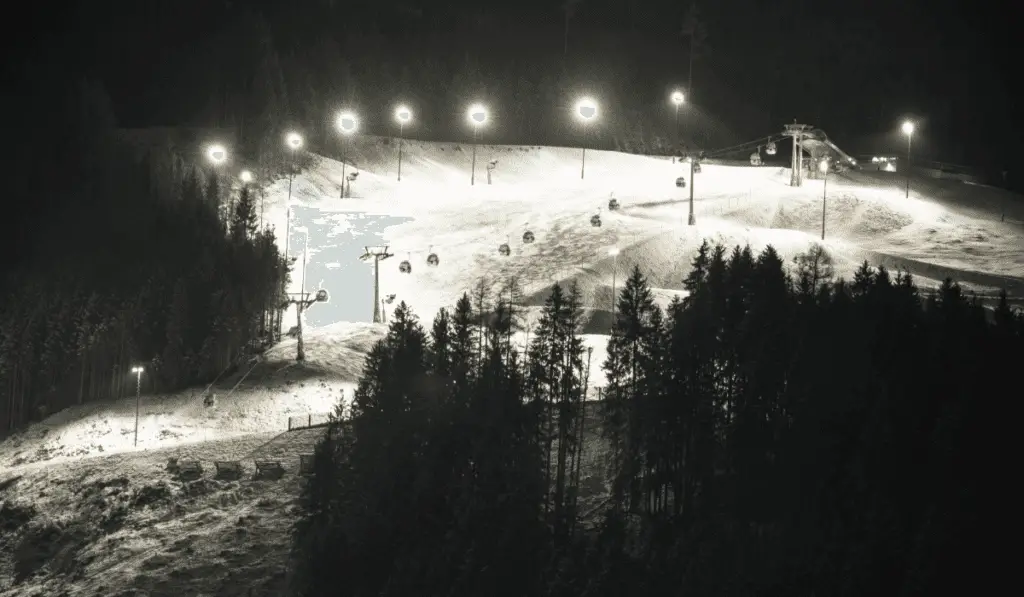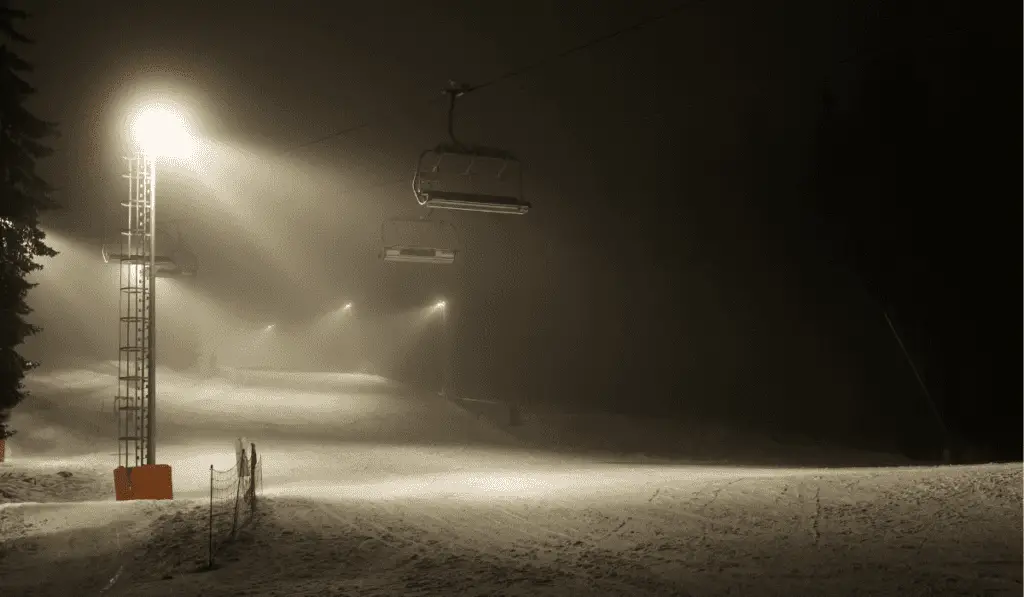Night skiing is a unique experience and one that everyone should try to do at least once in their lifetime.
If you’ve never night skied before or you’re looking for some advice then this article was written for you.
What is Night Skiing?
Night skiing is an activity offered at some resorts where skiers and snowboarders are able to make use of the slopes after dark. The ski slopes are often lit with LED lights to allow for better visibility. Night skiing starts after regular mountain hours and participants are usually required to buy a separate lift ticket.
In this article, we’ll cover some important questions you might have about night skiing, the correct gear to use and some tips if you’re a beginner.
Contents
- What Time Does Night Skiing Start?
- Is Skiing at Night Hard?
- Can Beginners Night Ski?
- Is it Better to Ski at Night?
- Do You Need Goggles to Ski at Night?
- What is the Best Color Lens For Night Skiing?
- Is Night Skiing Fun?
- Is Night Skiing Dangerous?
- Night Skiing Tips

What Time Does Night Skiing Start?
Night skiing typically starts after the end of the normal lift hours. Normal operating lift hours finish between 3 and 4 pm, so you can expect night skiing to start after that.
At most resorts, night skiing ends at around 9 pm.
This gives you enough time to get a few more runs in for the day and experience skiing under the stars.
One thing to note is that night skiing isn’t always available every night. We suggest you check in advance to confirm which nights you can ski. Most resorts have night skiing open on the weekend and holidays.
Is Skiing at Night Hard?
Night skiing can be harder than skiing during the day. Here are a few things to be aware of:
It’s going to be much colder at night. If you dress properly then this is something that is easily dealt with. If you don’t, then you can expect the experience to be less enjoyable and quite a bit harder than skiing during the day.
The snow can be icier at night. Snow melts during the day and then refreezes when the temperatures drop at night. This means that ice, hardpack and other less-than-ideal conditions can exist.
Visibility is different. Even though the slopes are lit up it can be difficult to see where you are going. The light and dark patches make it difficult even for experienced skiers.
The best way to deal with this is to make sure you wear the correct lenses in your goggles. For the best visibility, we recommend you use lenses that are either clear or yellow.
While skiing at night can be harder, as long as you dress warmly, use the correct lenses and are aware of the conditions, you’ll have just as much fun as you do during the day.
Can Beginners Night Ski?
Absolutely – assuming you ski on the well-lit, groomed slopes then beginners can ski at night.
In fact, the slopes are often less busy, so you can use it as an opportunity to practice and get some more skiing time in.
Most ski resorts with night skiing cater to all levels, opening up trails to suit beginner, intermediate and advanced skiers.
If it’s your first time night skiing, then make sure you dress warmly. Night skiing is much colder than during the day so you’ll need to layer up.
You should also be aware that even though the slopes are well-lit, visibility can be a challenge. Make sure you wear the correct goggles. It’s not advisable to wear the same goggles you would on a sunny day.

Is it Better to Ski at Night?
Night skiing certainly has its advantages over skiing during the day:
Lift tickets are cheaper than during the day. At almost every resort that offers night skiing, lift tickets are usually less expensive. This is because fewer people ski and the opening hours are slightly less than during the day.
Slopes are (often) less crowded. Most people prefer to ski and snowboard during the day. This just means there are fewer people on the mountain at night. Sure there are some expectations to this but in most cases, night-time skiing is less busy. This reduces lift wait times and means that you have more of the slope to yourself.
You can get more skiing in. With fewer people on the mountain and no lift lines, you’re able to get far more skiing in than you would typically be able to do during the day. By adding a few more hours of skiing to the day you’re simply able to get more skiing than at a resort that doesn’t offer night skiing.
Do You Need Goggles to Ski at Night?
While there is no requirement to wear goggles at night, and UV damage is not a concern, we recommend that you wear goggles at night to protect your eyes from cold, wind, snow and potential accidents.
Because there is less light at night, sunglasses or dark-tinted goggles are not recommended. These lenses are designed for daylight conditions and will make it very difficult for you to see at night.
Instead, we recommend choosing goggles that have either a clear or yellow lens.
These provide protection from the elements and help improve visibility by reducing any glare from the artificial bright lights.
What is the Best Lens Color for Night Skiing?
The best color lenses for night skiing are either clear or yellow.
Which one of these colors comes down to personal preference and is something you’ll need to try out for yourself.
These lenses allow for more light to pass through. The technical term for this is called visible light transmission (VLT).
Night skiing (and low daylight conditions e.g. cloudy or snowing) requires lenses with a high VLT. A higher VLT means that more light passes through making it easier to see at night.
Is Night Skiing Fun?
Night skiing is a lot of fun as long as you’re warm and have the right equipment.
There are few things more enjoyable than the wide open slopes (nights are usually quieter), shorter lift lines, a few extra hours on the slopes and skiing under the stars.
Night skiing is also not something that is offered by all ski resorts so when you do get the opportunity to ski at night it’s a pretty unique experience to share with friends and family.
Just make sure you’re adequately dressed and well-rested. The fun factor will disappear quickly if you’re cold and tired from a full day of skiing.
Is Night Skiing Dangerous?
Night skiing is not dangerous if you have the right gear and keep to the groomed and well-lit slopes.
To make night skiing as safe as possible we recommend the following:
Make sure you’re wearing the correct lenses (white or yellow) so that you can see properly. Visibility can actually be better at night because you never have to deal with flat light when skiing under the lights.
You’re aware of the snow conditions. If you happen to be in a ski area that warms up during the day and has cold nights then you’ll need to take this into account when skiing at night.
The warm day causes the snow to melt; at night, when the temperatures drop, this melted snow freezes, creating icy conditions. These are less-than-ideal conditions and probably best avoided if you’re a beginner.
Finally, make sure you aren’t overdoing it. Skiing is a physically demanding sport and if you’ve already spent a full day on the mountain you’re likely to be tired. This is when most injuries occur.
If you’re thinking of going night skiing, consider reducing your hours on the mountain during the day so that you can enjoy the night safely.

Night Skiing Tips
In this article we’ve covered some of the common questions we receive about skiing at night.
To wrap things up we’re going to leave you with a few useful tips if you’re thinking about hitting the slopes after the sun sets:
1. Dress warmly
The temperatures drop at night. This means you’ll need to layer up and wear extra gear. Your extremities such as hands, feet and head are likely to get the coldest so focus on keeping them warm. This will ensure you have a much more pleasant experience on the slopes and don’t call it an early night.
2. Use the correct lenses
Make sure you either use clear or yellow lenses to protect your eyes and help you see better.
3. Take it easy to start
Skiing at night takes a different set of skills and while the slopes might be quieter we always recommend taking it easy to start, especially if it is your first time.
4. Don’t ski alone
This rule is just as applicable to skiing during the day. At night with fewer people on the mountain, it always helps to have a buddy with you in case something goes wrong.
5. Have fun.
This goes without saying but skiing at night is a unique experience that not all resorts offer. If you get the chance then get out there and make the most of it. If you happen to be able to share it with friends it will be an experience you’ll never forget!
